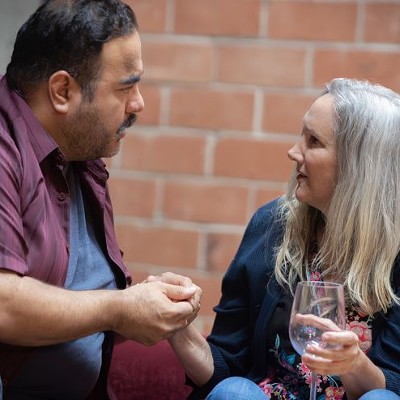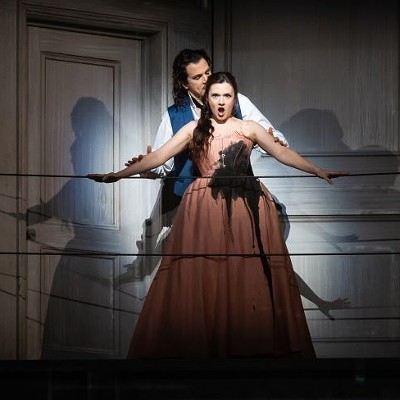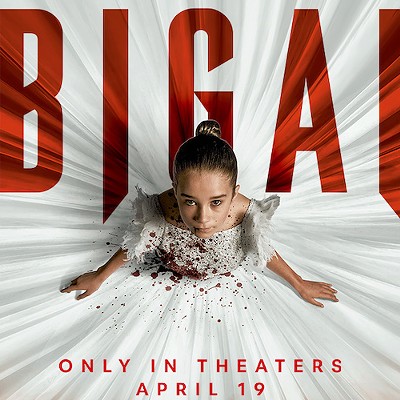British born, NYC-based painter Richard Butler is a Houstonian - he just doesn't know it yet. H-Town's vibrant, diverse and impossible-to-classify visual arts scene, as well as its plethora of experimental music makers, belies any preconceptions of conservatism those just passing through may carry with them like so much unnecessary baggage. At the risk of being pat, if we can agree that Houston's visual artists often combine formidable technique with genuine empathy for the truly weird, then Butler is certainly a kindred spirit.
Butler has a worldly eye for the surreal and the shocking, but there's tenderness in his works as well, especially in the portraits of his daughter. His paintings will resonate with those familiar with the work of painters David McGee or Kevin Peterson, two Houston-based artists each with a respective take on "realist" painting that is as seductive as it is disconcerting.
Given the demands of a current tour and upcoming Warehouse Live show with his band The Psychedelic Furs (note: Houston is the birthplace of psychedelic music), Butler may only end up with a fleeting impression of Houston's artists, museums, galleries, and off the wall spaces. We hope that he'll make a return visit soon. In the meantime, Butler provides us with some provocative answers to questions we put to him about painting and the relationship he experiences with his images.
Art Attack: Your paintings have both a painterly and photographic quality to them. The images can be intensely surreal, seeming to be both tactile and hallucinatory. What exactly are we looking at? Can you break down your process for us? ÿ
Richard Butler: My process is invariably that I work from photographs. I take photographs of my subject, most often my daughter. I then import these images into Photoshop. This is where I mess around with scale, composition and any patterns or backgrounds, etc. I have a fairly good idea from this what the final painting may look like. However, these are not photo-realistic paintings that I am making. Paint has qualities of its own, as does the application of paint. I like to see brush marks and gesture. I feel if one is making a painting you should maximize the particular qualities that the medium has to offer. The actual color of the painting is always very different to the image I am working from. Also the process of making a painting always offers up its own set of problems to be solved in a direct way on the canvas.
AA: The people in your more nightmarish portraits - some featuring halos of skulls or incredibly fat or scrawny people wearing strange masks and costumes - seem to have been painted with a deep feeling of empathy for the human condition. Do you feel something for these peculiar characters you paint - the more grotesque, bizarrely shaped and otherworldly figures populating your work?
RB: I personally feel my paintings have a certain melancholy, although it is not through planning entirely. It is only when I can stand back from a painting and 'feel' a certain presence and certain empathy for the subject that I consider the painting to be 'working.' There is a certain quiet and depth that I am striving for. And, I suppose, a particular sadness.
AA: Do your images surprise you? Do you begin with a visual in mind that, in the process of creation, transforms itself to be something quite different?
RB: Yes, my images surprise me. Although, there is always a 'recognition' - recognition of myself I suppose. In a way I think all of my paintings are self-portraits in that though the face I am painting may not be my own, the feeling I get back from the painting is certainly an important element of my own psyche. Hence the 'recognition.'
AA: How did the opportunity to study painting come to you as a young man? Was that an unusual decision for a young person to make in England in that time? There is a lot of hostility towards arts and arts education now in the U.S. But what was it was like when you were a kid and what is the atmosphere in Europe like today comparatively?
RB: My decision to go to art school at that time was not considered an unusual one. I think the atmosphere in Europe with regards to the arts may be more conducive to this. I don't think that this has really changed. Artists in the UK seem to be more 'in the news' than here in the US. Certainly artists such as Damien Hirst and Tracey Emin are household names.
AA: Where can people go to see your work? ÿ
RB: My work is mainly in private collections. But some can be seen on gallery websites, most notably and recently http://www.freightandvolume.com





